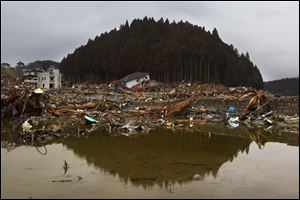
Japanese scramble to release radioactive water into ocean
Storage room needed for more with higher contamination
4/5/2011
Ruins of a neighborhood in Minamisanriku, a town in northeast Japan, surround a pool of seawater. Of the 17,666 people who once lived there, 300 have been confirmed dead; thousands more are missing.
TOKYO -- The operator of Japan's damaged Fukushima nuclear plant began releasing about 11,500 tons of radioactive water into the sea last evening to make room in storage tanks for even more severely contaminated water.
The amount of water being released is equivalent to more than four Olympic-size swimming pools.
Although the water being released had levels of radioactive iodine-131 more than 100 times the legal limit allowed for sea discharge, the government approved the release as an "emergency" measure so water with 100,000 times more radiation can be removed from the basement of the turbine building at reactor No. 2 and stored on the site.
Even as the government said release of the water would not pose an immediate threat to humans, health official Taku Ohara said the officials considered drawing up radioactivity food-safety standards for fish after high radiation levels were detected in a sand lance, a bottom-feeding fish, caught off Ibaraki prefecture's coast.
Nuclear experts have assumed radioactive iodine, which has a brief half-life, would become diluted in the ocean and decay too quickly to be detected in fish, but Monday's finding has raised doubts, Mr. Ohara said.
According to the health ministry, the sand lance had 4,080 bequerels per kilogram of radioactive iodine.
"We think the level found poses no immediate risk to people's health, but the point is moot anyway because all sand lance caught in Ibaraki were disposed of," he said.
By comparison, the level of radioactive iodine in the fish was twice as high as the limit for vegetables. There are no standards for radioactivity in meat, eggs, fish, and grains.
After weeks of cooling the disabled reactors by spraying them with thousands of tons of water using fire trucks, concrete pumpers, and helicopters, Tokyo Electric Power Co. faces a problem of what to do with the contaminated water. Removing it from turbine buildings and other structures is vital for workers to restore cooling functions to the facilities.
The utility reported no success in its efforts to stop highly radioactive water from seeping from a pit near the No. 2 reactor into the ocean.
The utility believed the leak was coming from an 8-inch crack and tried to seal it with a polymer, sawdust, and shredded newspaper.
When that failed, the utility dumped some white bath salts into a pipe near the pit to attempt to trace the flow of the water, but the colored water had yet to show up in the sea.
In a bit of positive news, national broadcaster NHK reported that a dog rescued Saturday by coast guard officers from the roof of a destroyed house floating more than a mile off the coast of northeastern Japan had been reunited with its owner.
The owner of the dog, a 2-year-old mutt named Ban, said she saw the news of the rescue on TV over the weekend and contacted authorities immediately.